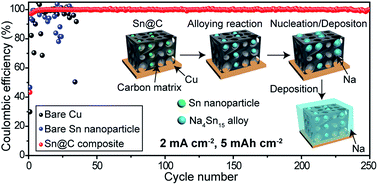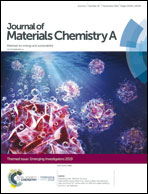Tin nanoparticles embedded in a carbon buffer layer as preferential nucleation sites for stable sodium metal anodes†
Abstract
Sodium (Na) metal is one of the most appealing anode materials for grid-scale energy storage systems owing to the high earth abundance and low cost of Na resources. Nevertheless, the implementation of the Na metal anode is hindered by two primary issues associated with Na dendrite growth and volume expansion, resulting in low coulombic efficiency and poor cycle life. Herein we present a facile and scalable method to synthesize tin (Sn) nanoparticles (NPs) that are uniformly embedded within a carbon network (denoted as Sn@C composite), which can address the two issues simultaneously. Specifically, Sn NPs can serve as preferential nucleation sites to guide Na nucleation and thereby lower the Na deposition overpotential, while the carbon network can act as a buffer layer to effectively minimize the volume change and alleviate the exfoliation of Sn NPs over repeated cycles. Consequently, high-capacity Na anodes can be realized with long-term reversibility and stability. Moreover, a room-temperature Na–sulfur battery based on the Sn@C composite as an anode coupled with commercial sodium sulfide as a cathode was demonstrated to have significantly improved electrochemical performance. We believe that this work provides a new pathway for designing high-energy Na metal batteries.

- This article is part of the themed collection: Journal of Materials Chemistry A Emerging Investigators


 Please wait while we load your content...
Please wait while we load your content...
